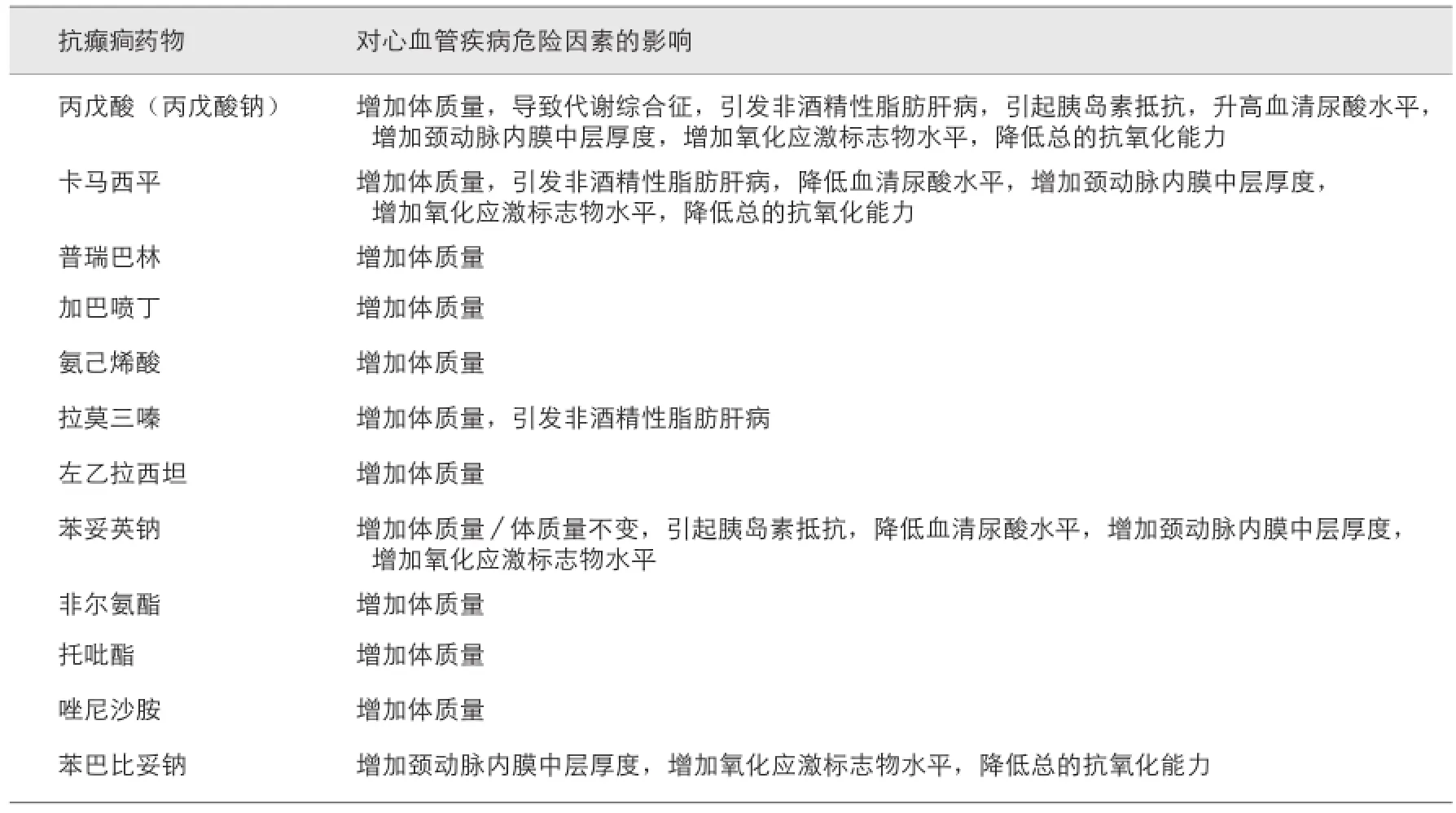抗癫药物与心血管疾病危险因素
王新新,陆钦池
上海交通大学医学院附属仁济医院神经内科,上海 200127
综述Review
王新新,陆钦池
上海交通大学医学院附属仁济医院神经内科,上海 200127
摘要
陆钦池
qinchilu@yahoo.com
CONFLlCT OF lNTEREST: The authors have indicated they have no conflicts of interest to disclose.
Received Jan. 18, 2016; accepted for publication 1. March, 2016
Copyright © 2016 by Journal of Neurology and Neurorehabilitation
To
cite: WANG X X, LU Q C. Antiepileptic drugs and risk factors of cardiovascular disease. J Neurol and Neurorehabil, 2016, 12(1):36–40.
LU Qinchi
E-MAIL ADDRESS
qinchilu@yahoo.com
ABSTRACT
There is a reciprocal causal relationship between epilepsy and cardiovascular disease (CVD),which means that epilepsy may increase the incidence rate and mortality of CVD, while the CVD may induce the sudden unexpected death in epilepsy. Different antiepileptic drugs have different effects on the risk factors of CVD including body weight, insulin resistance,metabolic syndrome, serum uric acid level, carotid artery intima-media thickness and markers of oxidative stress. In view of the fact that some antiepileptic drugs may increase or reduce the risk of occurrence of CVD, therefore, in individualized antiepileptic therapy,appropriate antiepileptic drugs should be selected for patients with high risk of CVD,meanwhile, the rational use of drugs which can reduce the risk of CVD is recommended.
2 心血管疾病与癫猝死的关系
3.1 受抗癫痫药物影响的心血管疾病危险因素
心血管疾病危险因素是指能够增加心血管疾病发生风险的因素。某些抗癫药物可增加心血管疾病的发生风险,提高心血管疾病的发生率及死亡率。抗癫药物影响的心血管疾病危险因素主要包括体质量、胰岛素抵抗、代谢综合征(metabolic syndrome,MetS)、颈动脉内膜中层厚 度(carotid intima-media thickness,CIMT)、血清尿酸水平和氧化应激标志物等。
体质量增加、胰岛素抵抗及MetS是常见的血管危险因素,3者相互伴随且互为因果。体质量增加常伴随胰岛素抵抗及MetS,使血清胆固醇水平升高,继而引发动脉粥样硬化。此外,体质量增加、胰岛素抵抗及MetS可通过扩血管物质(一氧化氮)、缩血管物质(内皮素)及凝血因子(纤溶酶原激活物抑制因子1)的合成失平衡而导致血管内皮功能障碍[10]。伴胰岛素抵抗的MetS患者的一氧化氮合成减少,而内皮素及纤溶酶原激活物抑制因子1合成增加,从而使血管过度收缩且抗凝能力下降,继而导致血管内皮细胞受损,加速血栓及动脉粥样硬化斑块的发生进程,进而增加心血管疾病发生风险[10]。
血清尿酸水平与心血管疾病的发生率和死亡率均密切相关。血清尿酸水平升高可增加心血管疾病发生风险。已有研究表明,尿酸具有致炎及促进氧化应激的作用[11],可作为MetS的提示因素,参与动脉粥样硬化过程[12],增加动脉纤维化患者的卒中风险。血清尿酸水平与冠状动脉粥样硬化患者10年生存率密切相关。此外,血清尿酸水平还可作为CIMT的预测指标。CIMT是预测动脉粥样硬化程度的标志,并且是独立于其他心血管疾病危险因素(例如:年龄、性别、舒张压、高密度脂蛋白和低密度脂蛋白等)的一项预测指标。CIMT已被作为心血管疾病危险因素预测的重要检测指标之一。
基质金属蛋白酶9(matrix metalloproteinase-9,MMP-9)作为氧化应激标志物,参与了动脉粥样硬化、动脉瘤形成(斑块的发展及不稳定脱落)及血管成形术中的内膜增生。在血管再生过程中,伴随炎性反应,细胞外基质增生;MMP-9分泌增加可使细胞外基质过度增生,继而引发动脉瘤形成、血管重塑、动脉粥样硬化以及心力衰竭等[13]。
3.2 不同的抗癫药物对心血管疾病危险因素的影响
CIMT既是心血管疾病危险因素,又是一项预测指标。除拉莫三嗪以外,卡马西平、丙戊酸和苯妥英钠单药治疗均可导致CIMT的增加[27]。更重要的是,在罹患癫的个体中,男性患者的CIMT大于女性患者。除年龄、性别和氧化应激因素以外,使用抗癫药物的时间长度也与CIMT存在一定的相关性。上述研究结果提示,长期使用抗癫药物在一定程度上参与了劲动脉粥样硬化的进展。

表1 不同的抗癫痫药物对心血管疾病的危险因素的影响[14–18, 27–29]
已有研究表明,卡马西平、丙戊酸钠和苯巴比妥钠治疗均可导致氧化应激标志物(氧化低密度脂蛋白、丙二醛、硫代巴比妥酸反应物、过氧化氢脂质、非对称性二甲基精氨酸)水平的升高,并导致总的抗氧化能力的下降[28-29]。然而,目前有关抗癫药物对氧化应激标志物的影响的研究还很少,因此尚无法得出较为肯定的结论。
4 结 论
参考文献
[1] WU Y, LlU D, SONG Z. Neuronal networks and energy bursts in epilepsy[J]. Neuroscience, 2015(287):175–186.
[2] CONRAD J, PAWLOWSKl M, DOGAN M, et al. Seizures after cerebrovascular events: risk factors and clinical features[J]. Seizure,2013, 22(4):275–282.
[3] ATHYROS V G, KAKAFlKA A l, PAPAGEORGlOU A A,et al. Effect of a plant stanol ester–containing spread, placebo spread, or Mediterranean diet on estimated cardiovascular risk and lipid, inflammatory and haemostatic factors[J]. Nutr Metab Cardiovasc Dis, 2011,21(3):213–221.
[4] LAMBERTS R J, BLOM M T, WASSENAAR M,et al. Sudden cardiac arrest in people with epilepsy in the community: Circumstances and risk factors[J]. Neurology, 2015,85(3):212–218.
[5] BROTHERSTONE R, BLACKHALL B,MCLELLAN A. Lengthening of corrected QT during epileptic seizures[J]. Epilepsia, 2010,51(2):221–232.
[6] GOLDMAN A M, GLASSCOCK E, YOO J, et al. Arrhythmia in heart and brain: KCNQ1 mutations link epilepsy and sudden unexplained death[J]. Sci Transl Med, 2009,1(2):2ra6.
[7] JEHl L, SCHUELE S. Sudden death in epilepsy Where is the “heart”of the problem?[J]. Neurology, 2015,85(3):208–209.
[8] TOLSTYKH G P, CAVAZOS J E. Potential mechanisms of sudden unexpected death in epilepsy[J]. Epilepsy Behav, 2013,26(3):410–414.
[9] LA ROVERE M T. Baroreflex sensitivity as a new marker for risk stratification[J]. Z Kardiol, 2000(89 Suppl 3):44–50.
[10] AHlRWAR A K, JAlN A, SlNGH A, et al. The study of markers of endothelial dysfunction in metabolic syndrome[J]. Horm Mol Biol Clin lnvestig, 2015, 24(3):131–136.
[11] TSOULl S G, LlBEROPOULOS E N,MlKHAlLlDlS D P, et al. Elevated serum uric acid levels in metabolic syndrome: an active component or an innocent bystander?[J]. Metabolism, 2006, 55(10):1293–1301.
[12] PATETSlOS P, RODlNO W, WlSSELlNK W,et al. ldentification of uric acid in aortic aneurysms and atherosclerotic artery[J]. Ann N Y Acad Sci, 1996(800):243–245.
[13] SlEFERT S A, SARKAR R. Matrix metalloproteinases in vascular physiology and disease[J]. Vascular, 2012,20(4):210–216.
[14] PYLVÄNEN V, KNlP M, PAKARlNEN A J, et al. Fasting serum insulin and lipid levels in men with epilepsy[J]. Neurology, 2003,60(4):571–574.
[15] SVALHElM S, LUEF G, RAUCHENZAUNER M,et al. Cardiovascular risk factors in epilepsy patients taking levetiracetam,carbamazepine or lamotrigine[J]. Acta Neurol Scand Suppl, 2010(190):30–33.
[16] ZENG K, WANG X, Xl Z, et al. Adverse effects of carbamazepine, phenytoin, valproate and lamotrigine monotherapy in epileptic adult Chinese patients[J]. Clin Neurol Neurosurg,2010, 112(4):291–295.
[17] LUEF G, RAUCHENZAUNER M, WALDMANN M,et al. Non–alcoholic fatty liver disease (NAFLD), insulin resistance and lipid profile in antiepileptic drug treatment[J]. Epilepsy Res,2009, 86(1):42–47.
[18] RlNG H A, HELLER A J, MARSHALL W J, et al. Plasma uric acid in patients receiving anticonvulsant monotherapy[J]. Epilepsy Res,1991, 8(3):241–244.
[19] FlLlPPATOS T D, KlORTSlS D N,LlBEROPOULOS E N, et al. Effect of orlistat,micronised fenofibrate and their combination on metabolic parameters in overweight and obese patients with the metabolic syndrome: the FenOrli study[J]. Curr Med Res Opin,2005, 21(12):1997–2006.
[20] ATHYROS V G, MlKHAlLlDlS D P,LlBEROPOULOS E N, et al. Effect of statin treatment on renal function and serum uric acid levels and their relation to vascular events in patients with coronary heart disease and metabolic syndrome: a subgroup analysis of the GREek Atorvastatin and Coronary heart disease Evaluation (GREACE) Study[J]. Nephrol Dial Transplant,2007, 22(1):118–127.
[21] DEROSA G, MAFFlOLl P. Effects of amlodipine plus atorvastatin association in hypertensive hypercholesterolemic patients[J]. Expert Rev Cardiovasc Ther,2010, 8(6):835–843.
[22] DASKALOPOULOU S S, ATHYROS V G,ELlSAF M, et al. The impact of serum uric acid on cardiovascular outcomes in the LlFE study[J]. Kidney lnt, 2004,66(4):1714–1715.
[23] YUEN A W, SlNGH R, BELL G S, et al. The long–term retention of pregabalin in a large cohort of patients with epilepsy at a tertiary referral centre[J]. Epilepsy Res, 2009,87(2–3):120–123.
[24] SCHERNTHANER G. Pleiotropic effects of thiazolidinediones on traditional and non–traditional atherosclerotic risk factors[J]. lnt J Clin Pract, 2009, 63(6):912–29.
[25] FlLlPPATOS T D, KlORTSlS D N,LlBEROPOULOS E N, et al. A review of the metabolic effects of sibutramine[J]. Curr Med Res Opin, 2005, 21(3):457–466.
[26] DASKALOPOULOU S S, ATHYROS V G,ELlSAF M, et al. Uric acid levels and vascular disease[J]. Curr Med Res Opin, 2004,20(6):951–954.
[27] CHUANG Y C, CHUANG H Y, LlN T K, et al. Effects of long–term antiepileptic drug monotherapy on vascular risk factors and atherosclerosis[J]. Epilepsia, 2012,53(1):120–128.
[28] OZ O, GÖKÇlL Z, BEK S, et al. ls asymmetric dimethylarginine responsible for the vascular events in patients under antiepileptic drug treatment?[J]. Epilepsy Res, 2009,87(1):54–58.
[29] AYClCEK A, lSCAN A. The effects of carbamazepine, valproic acid and phenobarbital on the oxidative and antioxidative balance in epileptic children[J]. Eur Neurol, 2007, 57(2):65–69.
DOI:10.12022/jnnr.2016-0021
通信作者
CORRESPONDING AUTHOR
Antiepileptic drugs and risk factors of cardiovascular disease
WANG Xinxin, LU Qinchi
Department of Neurology, Renji Hospital, Shanghai Jiao Tong University School of Medicine, Shanghai 200127, China
KEy WORDS:Epilepsy; Sudden unexpected death in epilepsy; Antiepileptic drugs; Cardiovascular disease;Risk factors

